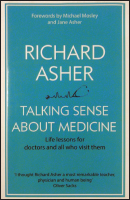Translate this page into:
Talking Sense about Medicine
Corresponding Author:
Sanjay Pai
Department of Pathology, Columbia Asia Referral Hospital, Bengaluru, Karnataka
India
sanjayapai@gmail.com
| How to cite this article: Pai S. Talking Sense about Medicine. Natl Med J India 2017;30:238 |
Talking Sense about Medicine. Richard Asher. Psychology News Press, London, 2015. 262pp, £14.99. ISBN 978–0–907633–40–2.

Few books remain fresh after 50 years. And even fewer can be predicted to stay fresh for the next 50 years. While it is often foolhardy to make predictions, it is safe to state that Richard Asher’s writings will be as relevant in the future as they are today and were, when they were first written over 50 years ago.
This is a collection of some of his essays, which should be made compulsory reading for all students and doctors. This edition has explanatory terms for many medical terms and includes the general public in its readership; thus, I would venture to say that every reasonably intelligent person should read this book. Some years ago, we had made a list of books for a bedside library for doctors (BMJ 2005;331:1482). I would unhesitatingly add this book to the list.
This book has forewords written by Jane Asher (his daughter), Michael Mosely (the doctor and science documentary maker) as well as a publisher’s foreword written by David Cohen. The original essays are reproduced here without Bowdlerization, and hence, as his daughter writes, there are some phrases, which were acceptable in the 1950s (e.g. the words ‘queer’ and ‘Mongolism’), but that would be frowned upon today.
Asher’s contributions to medicine are remarkable. Most doctors and even medical students would know about a condition that he was the first to describe: Munchausen syndrome, in which patients suffer from factitious illness. His more important paper is the concept of myxoedematous madness. Though he acknowledges that he was not the first to document it, it was his case series in the British Medical Journal in 1949 that made the practising physician aware of the condition. (I cannot understand why the original source of this as well as some other articles is not mentioned in the book). ‘Straight and crooked thinking’ and ‘Seven sins ofmedicine’ are two other essays that stand out.
But it is the spirit of enquiry that he had that is most important. It is obvious today to even the most junior of doctors that prolonged bedrest can be harmful to the patient—but a generation ago, bedrest was the norm. Hence, the essay, ‘The dangers of bed rest’ is refreshingly different and indeed, some would say that this was his greatest contribution to medical practice. Other examples of his originality in thinking are his beliefs that peptic ulcer has an organic cause and that most prescriptions are unnecessary.
An equally important reason to read this book is that it teaches us how to communicate science. Besides learning to write by just observing and studying the style adopted in this book, one can learn from the essays ‘Aren’t I lucky? I can write’, ‘Six honest serving men for medical writers’ and ‘Appendix’.
What would Asher have written about medicine today? What would his views be on guideline-based medicine, annual health checkups, impact factor of journals, malpractice suits and on political correctness in medicine? We will never know, but you can be sure of one thing: he would have had a refreshingly unusual point of view which would have highlighted aspects that most people have not thought of—and which would have been accepted, as par for the course, a quarter of a century later!
Fulltext Views
704
PDF downloads
339




